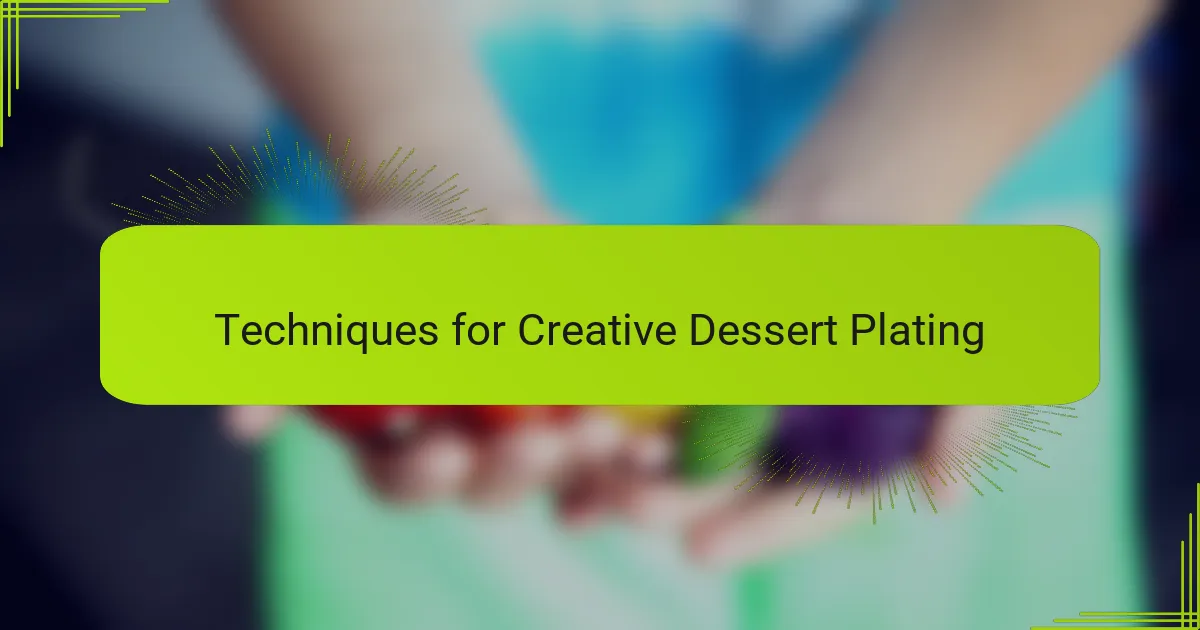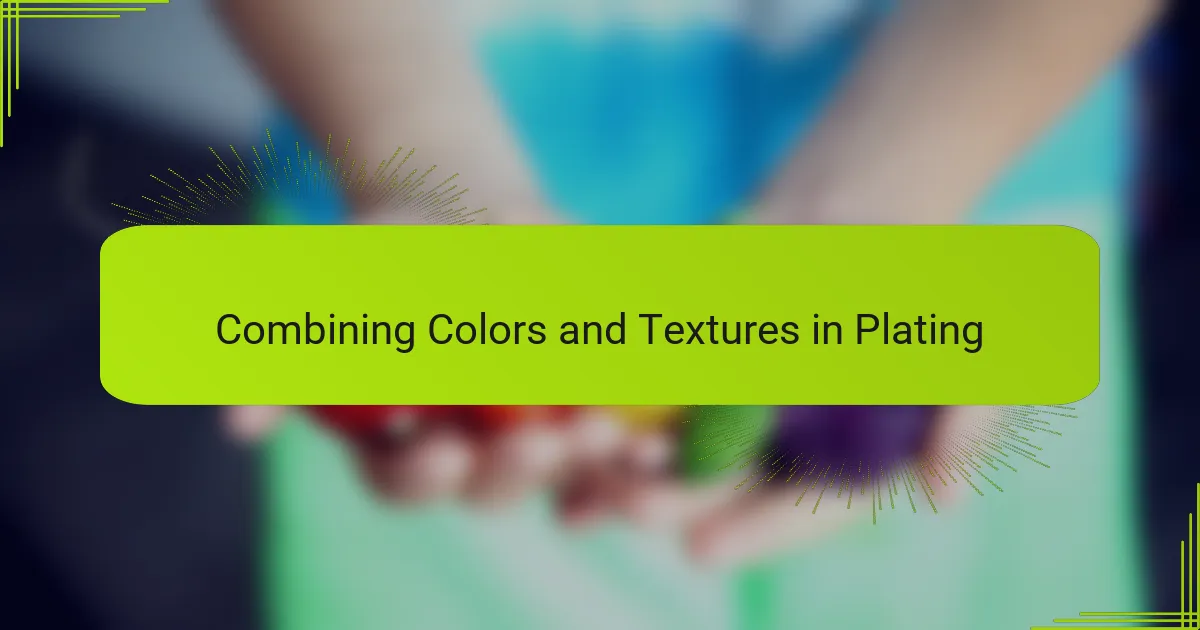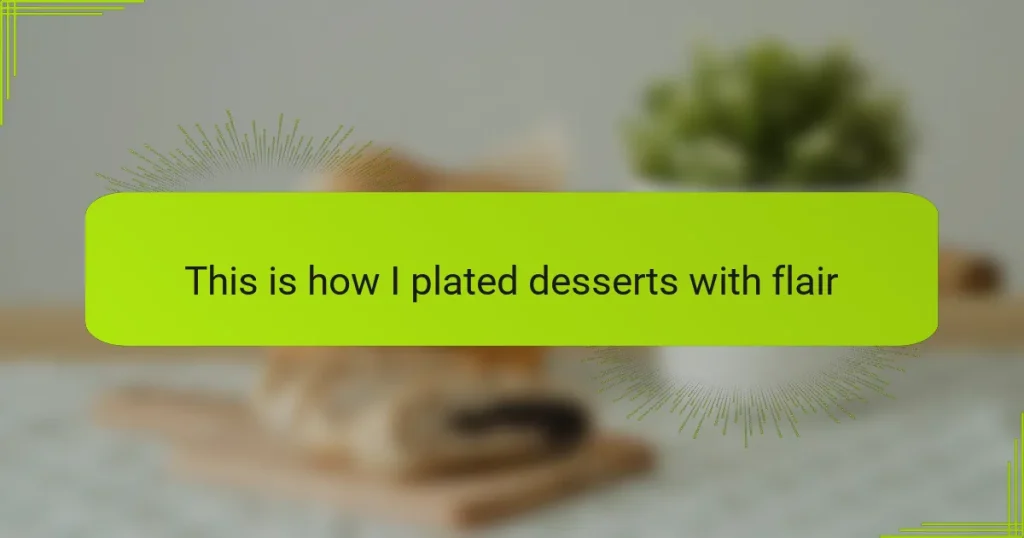Key takeaways
- Presentation enhances the dessert experience; balance shapes, colors, and textures for visual appeal.
- Use essential tools like offset spatulas, tweezers, and squeeze bottles for precise and creative plating.
- Choose desserts based on their structural integrity and textures, as they guide the plating style and visual interest.
- Incorporate unexpected garnishes and innovative sauce applications to add flair and elevate the overall presentation.

Understanding Dessert Plating Basics
When I first started plating desserts, I quickly realized that presentation isn’t just about looking pretty—it’s about enhancing the entire eating experience. Have you ever noticed how a well-arranged plate can almost make a simple dessert feel gourmet? That visual appeal sets the tone, making your taste buds anticipate something special even before the first bite.
One basic I always keep in mind is balancing elements on the plate—think about shapes, colors, and textures. For example, contrasting a smooth mousse with a crunchy garnish not only adds excitement but also draws the eye around the plate. It’s like telling a story visually, and that’s what dessert plating is all about.
Another thing I learned is to consider negative space—the empty areas around the dessert. Initially, I wanted to fill every inch with something edible, but giving your dessert room to breathe actually highlights its beauty more effectively. What’s your take on simplicity versus extravagance when it comes to plating? I find that sometimes, less truly is more.

Essential Tools for Dessert Presentation
One essential tool I always keep within arm’s reach is a good set of offset spatulas. These help me spread sauces or frostings smoothly and precisely, giving the plate a clean, professional look. Have you ever struggled with uneven swipes or messy dollops? Using the right spatula changed the game for me.
Tweezers may sound fancy, but they’re a must-have for placing delicate garnishes exactly where I want them. I remember the first time I used them to position tiny mint leaves—it made a huge difference in the detail and finesse of my presentation. Don’t underestimate how small tools can have a big impact.
Lastly, squeeze bottles are incredibly handy for creating patterns with sauces or coulis. I enjoy experimenting with dots, lines, or even abstract shapes that complement the dessert’s style. Playing with these artistic touches can turn a simple plate into something that feels truly special, don’t you think?

Techniques for Creative Dessert Plating
When I first started exploring creative plating, layering textures became my go-to technique. Combining a silky cream with a crunchy crumble not only added depth to the taste but also created a fascinating visual that made guests lean in closer. Have you tried mixing unexpected elements to surprise the eye and palate?
Working with height is another trick I often use. Elevating components—like stacking a macaron atop a dollop of mousse—adds dimension and drama to the plate. It’s amazing how just a little verticality can transform a flat, ordinary dessert into something that feels elevated and dynamic.
I also love playing with color contrasts to catch attention immediately. Bright berries against a dark chocolate backdrop create an irresistible focal point that draws the eye. Don’t you find that vibrant hues make desserts pop and invite you to dig right in? I certainly do—it’s like a visual invitation I can’t resist.

Choosing the Right Desserts to Plate
Choosing the right dessert to plate sets the entire mood for your presentation. I’ve found that lighter desserts like panna cotta or sorbet offer a clean canvas that lets creative garnishes shine, while rich cakes or tarts demand a more balanced, thoughtful arrangement to avoid overwhelming the senses. Have you ever noticed how the dessert itself guides your plating style?
Sometimes, I pick desserts based on how well they hold up visually. Think about how a delicate mousse might melt quickly, making intricate decorations tricky, while sturdier options like a tart or brownie give you the freedom to add height and layers without worrying. Does choosing a dessert with structure always make plating easier? For me, it often does.
Texture plays a huge role too. I love pairing smooth creams with crunchy elements not just for contrast in taste, but because it creates natural spots to add visual interest on the plate. When I think back, some of my best presentations started with a dessert that invited layering — it’s almost like the dessert invites you to tell a story on the plate.

Combining Colors and Textures in Plating
When I combine colors and textures in plating, I often think about how they can work together to create a mini visual feast. For instance, pairing a bright, glossy fruit compote with a matte, crumbly biscuit not only excites the eyes but sets up a delightful contrast that hints at the variety of flavors to come. Have you noticed how a pop of vibrant color beside a muted tone instantly catches your attention?
Textures play such a crucial role too. I remember plating a silky cheesecake topped with crunchy caramel shards and feeling that moment of satisfaction when the textures genuinely complemented each other—each bite offered something new. Isn’t it amazing how that interplay makes the dessert feel more dynamic and thoughtfully composed?
Color can also guide the mood of your plate. Sometimes, I deliberately use a splash of green mint or deep red berry to break the monotony, creating a fresh and inviting vibe. Do you find that thoughtfully chosen hues can even influence how you perceive the taste before you take a bite? For me, that visual cue is often the first impression on flavor.

My Personal Dessert Plating Process
My personal dessert plating process always begins with a moment of quiet observation—I look at the dessert itself and imagine how each component will play off the others visually and texturally. Have you ever found yourself staring at a dish, wondering where to place that final garnish? For me, that pause is crucial; it transforms plating from a task into a creative ritual.
I like to work from the center outward, starting with the main element and building around it using sauces, crumbs, or fresh fruit. Sometimes, I’ll even switch up my original plan if I sense a different placement will create a better balance or highlight a color contrast more effectively. It’s a bit like painting, except the canvas is edible, and every stroke must invite someone to taste.
One habit I’ve developed is stepping back frequently during plating to view the dessert from different angles. This helps me catch any imbalance or overcrowding before it’s too late. Have you noticed how a slight shift in perspective can reveal what your eyes missed up close? That practice has saved many plates from feeling cluttered and has made my presentations feel effortlessly elegant.

Tips for Adding Flair to Desserts
Adding flair to desserts often means daring to play with unexpected garnishes. I remember the first time I sprinkled edible flowers on a simple panna cotta—it instantly elevated the whole plate and sparked compliments I didn’t anticipate. Have you ever thought about how a small, colorful touch can completely change the vibe of your dessert?
Another tip I swear by is experimenting with sauce applications. Instead of just drizzling, try stamping, smearing, or creating dots with a squeeze bottle. It’s like giving your plate personality and movement, don’t you think? Those little abstract shapes often become the focal point that makes people stop and admire before tasting.
Finally, don’t underestimate the power of fresh herbs or spices. I once added a tiny sprig of rosemary to a chocolate tart, and that herbal hint paired surprisingly well while adding a sophisticated look. Have you noticed how scent and visual cues together can make a dessert feel more complex and inviting? That’s the kind of flair that makes your creation memorable.




